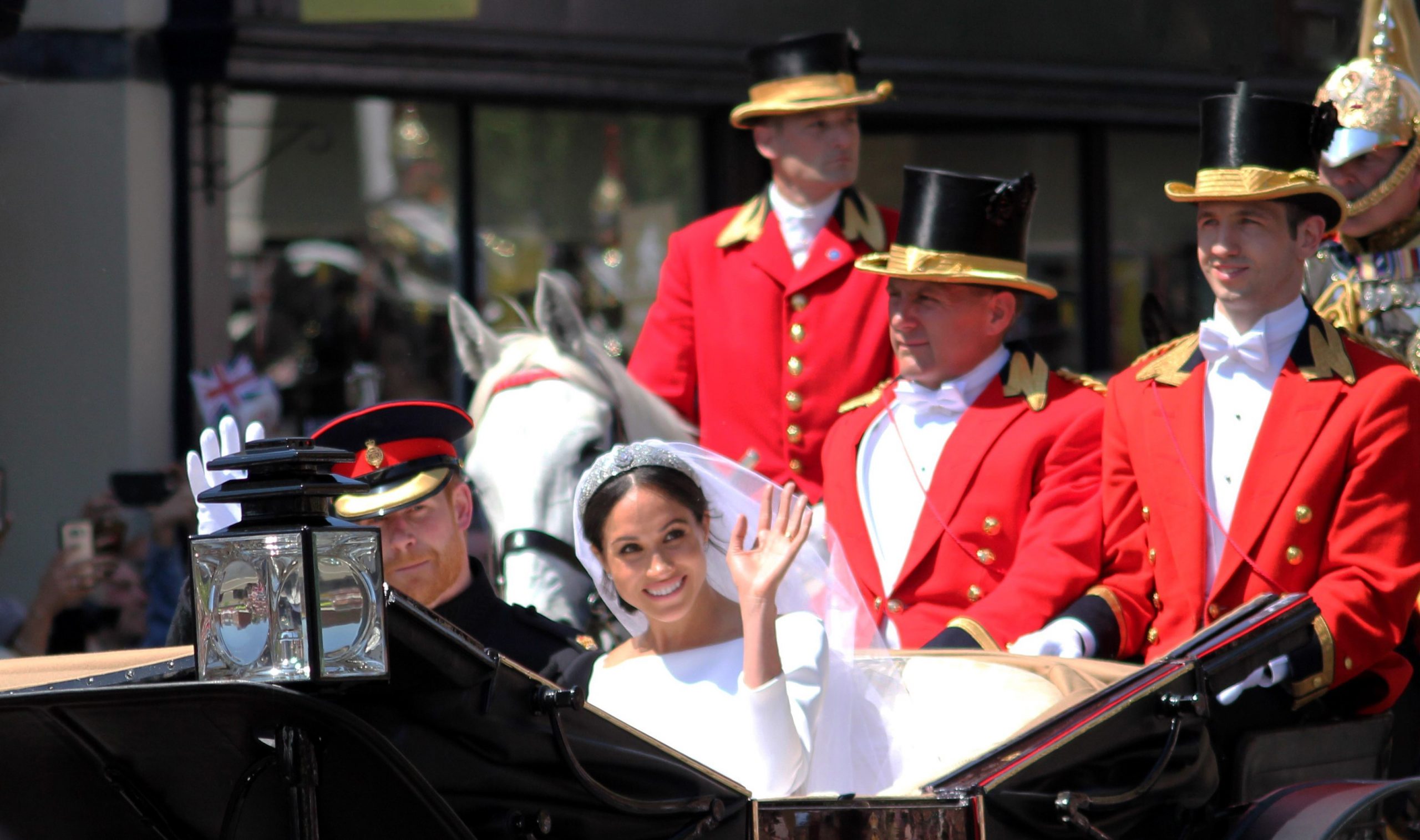“Prince Harry, Duke of Sussex, and Meghan Markle announced they would become financially independent of the Crown on January 8, 2020. Within a week, six new trademark applications were filed in the USPTO for ‘Sussex Royal.’”
 As you’ve most likely heard, Prince Harry and Meghan Markle have decided to become financially independent of the Crown. No small task when your security costs are reported to be $1.3 to more than $7 million per year. Ouch!
As you’ve most likely heard, Prince Harry and Meghan Markle have decided to become financially independent of the Crown. No small task when your security costs are reported to be $1.3 to more than $7 million per year. Ouch!
So, what are they planning to do? One hint can be found in the trademark application for “Sussex Royal” that they filed in England on June 21, 2019. This trademark filing provides the opportunity for many lessons to be learned.
The lessons:
- You can keep an eye open (snoop) on your competition.
- You should do a search to clear your trademark.
- You should file before you announce your plans.
- You should file in countries where you intend to use the trademark.
- You should take advantage of your first filing date when filing in other countries.
Snoop
A trademark application requires you to list the goods and services on which you intend to use the mark. Harry and Meghan’s is listed in their UK application. A summary of the goods and services it includes gives some hints as to their plans for this brand. They’re seeking registration for: printed matter, clothing, campaigning, charitable fundraising, education, and social care services, including licensing of intellectual property.
This gives us some indication of what they might be up to. This is also a good way to keep up on your competition. You should regularly watch your competition to determine what new products and services they may be planning to launch.
Clear your trademark
Have a search done to be certain that your trademark is available. You don’t want to pick a trademark that will result in a dispute. “Sussex Royal The Foundation Of The Duke And Duchess Of Sussex” filed for “Sussex Royal” in the United Kingdom Trademark Office on June 21, 2019. When the mark was published, several notices of opposition were filed against their application. It’s not going to be an easy process for them to get this trademark registered.
File before you announce
File your trademark application before you announce your intentions. If you don’t, your mark may be hijacked. Harry and Meghan made their announcement on January 8, 2020. Within a week, six new trademark applications were filed in the U.S. Patent and Trademark Office (USPTO) for “Sussex Royal.”That same day, an application for trademark registration was filed by a California man for Internet communication services. Two more were filed on the 13th by two separate individuals for curtains and towels, educational kits, and alcoholic beverages (Swiss Royal IPA?). Two were filed on the 14th for t-shirts, clothing, and stationery. Finally, on the 15th, another individual filed for children’s bed linens.
Canada also saw filings for “Sussex Royal” in its Trademark Office. Royal Mount Spirits Inc. filed on January 12th for clothing and alcoholic beverages. Juice Marketing filed on January 15th for kitchen accessories.
It seems to be more than a coincidence that these were filed shortly after the announcement by the Royals that they were striking out on their own.
In the United States you can file an intent to use application. Your mark can be allowed by the USPTO before you actually use it. Once you use it, it will then issue. This is a great way to protect your brand and protect yourself against hijackers.
File in all countries where you intend to use your trademark
The Royals have hinted that they may live in Canada and appear to be interested in the U.S. market. So, in addition to the United Kingdom, they should file in Canada and the United States, as well as other countries that are important to them. Remember those other filings? These can create issues for the Royals.
In the United States, you have trademark rights once you use the mark. You don’t have to register your mark to have rights, although it is much better to register. Unlike the United States, many countries have first-to-file systems. Whomever files first gets the trademark. This can create royal problems when you’re trying to later get trademark protection in those countries. Your trademark has basically been hijacked.
I recently represented a company that was being purchased. We learned that their European distributors had registered their trademarks in the distributor’s name. They were the first-to-file, and therefore technically owned the trademarks. To close the deal, we had to buy back our trademarks. To avoid this, file before you use.
Take advantage of your earlier filing date
Actually, they should have filed in the United States within six months of the filing in the United Kingdom to take advantage of that filing date. Many countries will recognize your earlier filing date in another country; however, you have to file in those countries within a specific period. It’s typically six months after your first filing. If the Royals had filed in the United States within six months of their United Kingdom filing, they would have had the filing date of June 21, 2019, the date they filed in the United Kingdom. This is critical to getting a U.S. registration. They would have been first, their trademark would be examined first, and everyone else’s suspended. Once their mark is registered, it’s then used to block anyone else trying to register a confusingly similar trademark.
It appears that the former Royals failed to do this. Now they may have a greater fight on their hands. There are earlier filings in Canada and the United States.
The Takeaway
Trademarks are valuable. They can be your most valuable asset. They should be carefully protected. They’re complex, particularly when you are planning to do business in other countries. Follow the lessons from Harry and Meghan to protect your trademarks in the United States as well as other countries. Your trademarks could be worth a king’s ransom.
Image Source: Deposit Photos
Photography ID: 196499494
Copyright: cheekylorns2

![[IPWatchdog Logo]](https://ipwatchdog.com/wp-content/themes/IPWatchdog%20-%202023/assets/images/temp/logo-small@2x.png)

![[Advertisement]](https://ipwatchdog.com/wp-content/uploads/2024/04/Patent-Litigation-Masters-2024-sidebar-early-bird-ends-Apr-21-last-chance-700x500-1.jpg)

![[Advertisement]](https://ipwatchdog.com/wp-content/uploads/2021/12/WEBINAR-336-x-280-px.png)
![[Advertisement]](https://ipwatchdog.com/wp-content/uploads/2021/12/2021-Patent-Practice-on-Demand-recorded-Feb-2021-336-x-280.jpg)
![[Advertisement]](https://ipwatchdog.com/wp-content/uploads/2021/12/Ad-4-The-Invent-Patent-System™.png)







Join the Discussion
5 comments so far.
Richard York
February 9, 2020 03:57 pmWith regards Stuart Fox’s moment above this article may be if interest:
https://www.worldtrademarkreview.com/enforcement-and-litigation/sussex-royal-trademark-meghan-and-harry-strong-legal-position
Virginia
February 9, 2020 02:58 pmAll your points are very valid – except that in this case they did not fail to protect their marks in their jurisdictions of interest, because their Madrid Protocol international application covers Australia, Canada, Europe, and the USA, and claimed Convention priority from their UK application.
Joachim Martillo
February 9, 2020 11:47 amI hope they also filed to trademark SussexRoyal.{com,.edu,.org,.net,.to,.co.uk,.uk.,etc.} in order to prevent hijacking of domain names.
Stuart Fox
February 9, 2020 07:09 amThe UK and many other countries have restrictions or prohibitions on words or insignia that may not be used in Trademarks or business names without permission – e.g. Olympic, Boy Scout, bank and Royal – in the case of the later word, permission must be applied for at the Lord Chamberlain’s Office acting on behalf of Her Majesty.
The use of certain Royal insignia as trade marks can also be protected internationally under the Paris Convention for the Protection of Industrial Property of 1883.
Article 6 (1) (a) of the Paris Convention states that:
“The countries of the Union agree to refuse or to invalidate the registration, and to prohibit by appropriate measures the use, without authorization by the competent authorities, either as trademarks or as elements of trademarks, of armorial bearings, flags, and other State emblems, of the countries of the Union, official signs and hallmarks indicating control and warranty adopted by them, and any imitation from a heraldic point of view”.
Section 4 (1) of the Trade Marks Act 1994 states:
“A trade mark which consists of or contains –
(a) the Royal arms, or any of the principal armorial bearings of the Royal arms, or
any insignia or device so nearly resembling the Royal arms or any such armorial
bearing as to be likely to be mistaken for them or it,
(b) a representation of the Royal crown or any of the Royal flags,
(c) a representation of Her Majesty or any Member of the Royal Family, or any
colourable imitation thereof, or
(d) words, letters or devices likely to lead persons to think that the applicant either has or recently has had Royal patronage or authorisation,
shall not be registered unless it appears to the registrar that consent has been given by or on behalf of Her Majesty or, as the case may be, the relevant Member of the Royal Family.”
The Lord Chamberlain’s Office is empowered to grant the consent referred to in
Section 4(1) on behalf of Her Majesty The Queen. The Lord Chamberlain’s Office
has a standard procedure and document to implement the grant of any such consent.
The consent is conditional on (inter alia) the proprietary rights in the registration
remaining with the applicant, and cannot be assigned without further consent.
Unauthorised Use
Section 99(1) of the Trade Marks Act 1994 states that “a person shall not without the authority of Her Majesty use in connection with any business the Royal arms (or arms so closely resembling the Royal arms as to be calculated to deceive) in such manner as to be calculated to lead to the belief that he is duly authorised to use the Royal arms”.
MaxDrei
February 8, 2020 02:47 pmBut but but………..
I had earlier read that H+M had filed at WIPO, with declaration of their UK priority date, to protect their mark world-wide. Here a Link to the story:
https://www.theguardian.com/uk-news/2020/jan/12/harry-and-meghan-seek-global-trademark-sussex-royal-brand
What difference, if any, will that make, in the USA? Incidentally, I see that they were both speaking in Miami, a couple of days ago, at a J P Morgan event in Miami.